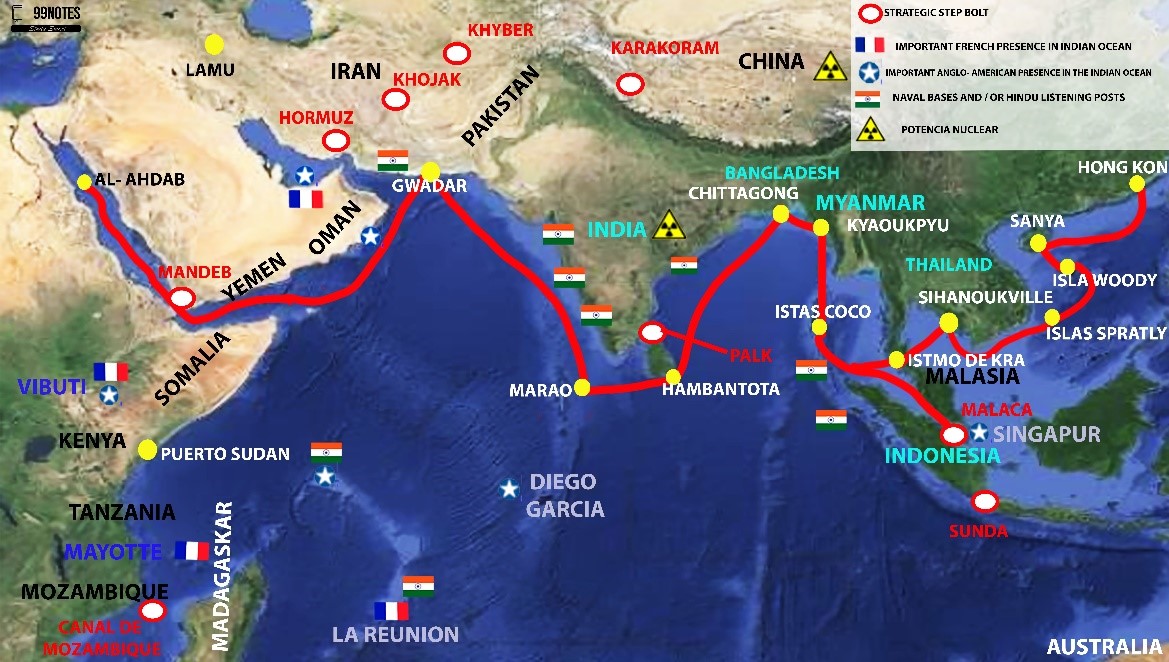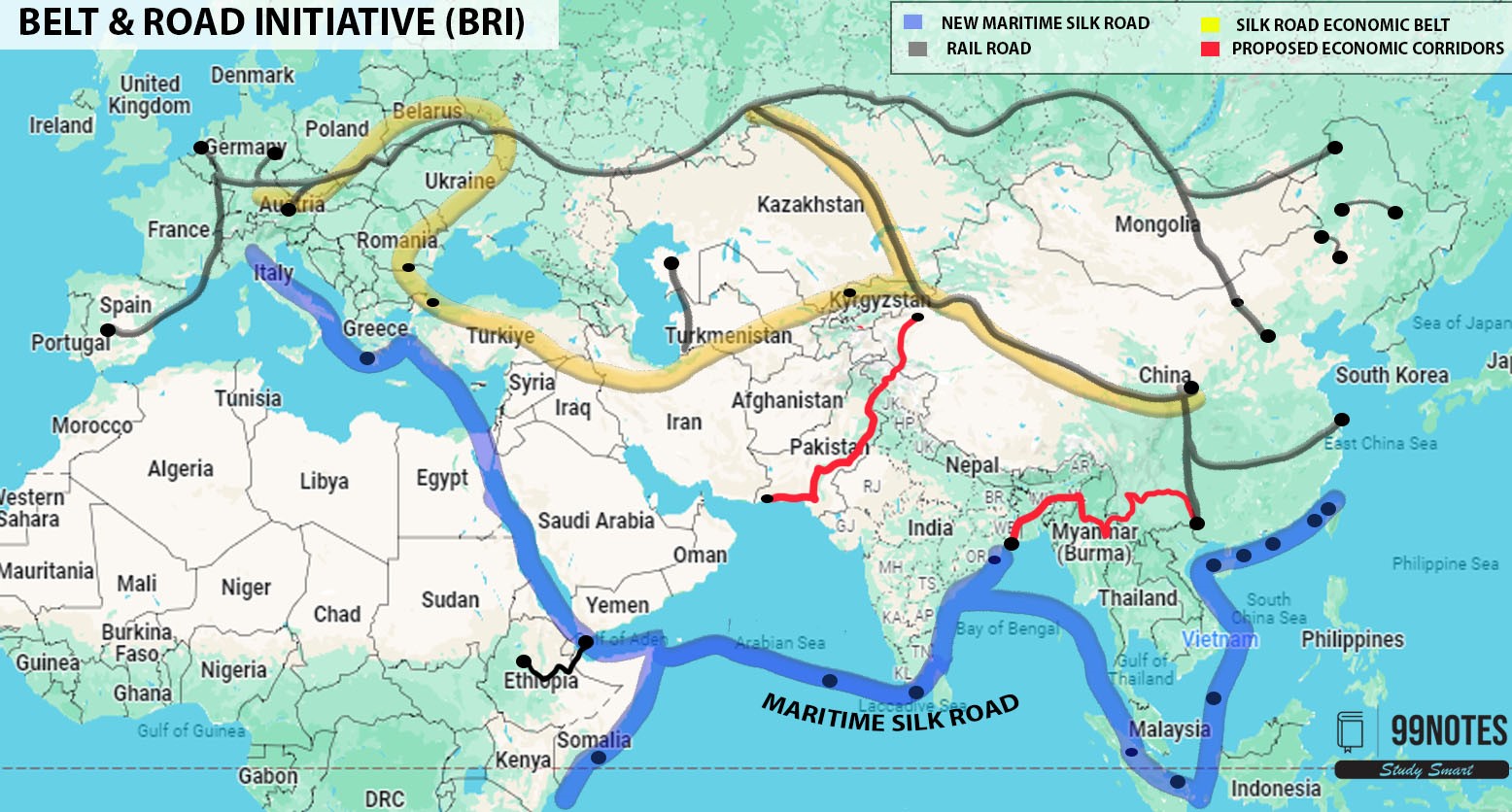India and China
India shares a border of 3488 km with China, which runs along the Union Territory of Jammu & Kashmir and the states of Himachal Pradesh, Uttarakhand, Sikkim, and Arunachal Pradesh. Separated by the Great Himalayan range, our border is characterized by difficult terrain and sparse habitation, which have resulted in inadequate development of infrastructure in these regions.
In the last 75 years, India and China have traversed through a difficult relationship, and have engaged in a major conflict in 1962. Since China is a major world power, balancing our relations with it is essential for India’s progress.
Historical evolution of the relationship
The India-China relationship has gone through ups and downs since India’s independence. China and India have maintained peaceful relations for thousands of years, as there have been cultural exchanges through travellers and trade relations through the Silk Route. However, the harmony of their relationship has varied in modern times with the victory of the communist party and the annexation of Tibet by China. We can trace the evolution of the India-China in the following table:
| Civilizational History | India-China relations can be traced back to the advent of Buddhism into China from India in the first century A.D. A Chinese monk, Fa Xian, visited India in AD 402, stayed for ten years, and after his return, translated many Sanskrit and Buddhist texts into Chinese. The cultural exchange took place through scholars from each side, like Hiuen Tsang, who wrote a book called “A Journey to the West”. After the spread of colonialism in both countries, cultural exchanges diminished. However, respective national struggles for freedom saw the resumption of contact, mutual interest, and feelings of solidarity. |
| 1950-1980 |
On 1 April 1950, India became the first non-socialist country to establish diplomatic relations with the China. The 1950s can be called the Hindi-Chini Bhai Bhai phase. Panchsheel Agreement Panchsheel, or the Five Principles of Peaceful Co-existence, were first formally declared in the Agreement on Trade and Intercourse between the Tibet region of China and India that was signed on 29 April 1954. It enumerates five principles to guide the agreements between two countries:
However, the border conflict in 1962 was a setback to India-China ties. |
Post-Cold war Relations:
China opened up its economy in the late 1970s, whereas India opened it in 1991, following the LPG (Liberalisation, Privatisation and Globalisation) reform. This paved ways for rise of China and India which consequently resulted in the global shift of power from the Trans-Atlantic to the Indo-Pacific region, especially since the 1990s. India and China’s growth was hailed as the beginning of the Asian Century. There has been start in the normalisation of the relation as follows:
| 1990- 2000 |
Improvement in the relationship began with Prime Minister Rajiv Gandhi’s landmark visit in 1988. Further, there has been improvement in the bilateral relationship with the signing of the Agreement on the Maintenance of Peace and Tranquility along the Line of Actual Control during Prime Minister Narasimha Rao’s visit. Agreement on the Maintenance of Peace and Tranquility It is also known as the Border Peace and Tranquility Agreement (BPTA). This agreement, for the first time, saw both sides legally commit to respecting the status quo and reducing the risk of an unplanned confrontation. Some of the major points include:
|
| 2000-2020 |
2003: India and China signed the Declaration on Principles for Relations and Comprehensive Cooperation. In this, both countries agreed to
2005: Two sides established a Strategic and Cooperative Partnership for Peace and Prosperity. This has led to an increase in trade between the two countries. India-China bilateral trade, which was as low as US$ 2.92 billion in 2000, reached US$ 61.7 billion in 2010. |
Recent development in Relations:
- Since 2000, China started challenging the hegemony of America in the economic, military, and technological spheres. Whereas India’s tilt towards the west has increased. Thus, China became sceptical about India, and started encircling India with the development of strategic ports around India, e.g., Chittagong Port in Bangladesh and Hambantota Port in Sri Lanka. China also started influencing India’s neighbourhood with its economic power. China wanted to contain India and limit its sphere of influence.
- India has responded to China’s assertiveness with increased military spending, modernisation of defence and increased infrastructure build-up in the border area. Similarly, India formed a strategic alliance with like-minded countries to counter China. For example, QUAD was formed to counterbalance China’s influence in the Indo-Pacific region. These steps further infuriated China.
- China responded with a military adventure on the Indo-China border. China increased its military presence, leading to confrontations like the Galwan Valley clash. This military manoeuvring is part of China’s broader strategy to assert control over disputed territories and to challenge India’s regional influence.
The discussion of the historical evolution of the relationship has provided background on the relationship with China. This will help us gain a holistic understanding of the relationship between India and China. Different dimensions of the relation can be analyzed through areas of convergence, divergence, cooperation and competition as follows
Area of cooperation:
Economic Cooperation:
Despite political and military tensions, India and China have significant economic ties. India-China economic cooperation began in the late 20th century, particularly after the two countries normalized relations following the 1962 border conflict. A Double Taxation Agreement (DTA) was signed between India and China on 18 July 1994. DTA’s are negotiated bilaterally between two states with the objective of avoidance of double taxation, allocation of taxing rights, and exchange of information. It enabled both economies to boast strong economic complementarity and great potential for cooperation.
- Trade between the two –China is 2nd biggest trading partner of India after the U.S. (in 2021-22, bilateral trade was USD 115 billion).
- Import from China: China is the top supplier in eight major industrial sectors in India. India’s imports from China surged to over $101 billion in 2023-24 from around $70 billion in 2018-19.
- Export to China: Exports to China remain at around $16 billion annually. Key Indian exports to China include raw materials such as iron ore, cotton, and chemicals
- Chinese Companies in India: More than 100 Chinese companies have established offices/operations in India. Many large Chinese state-owned companies in the field of machinery and infrastructure construction have won projects in India and have opened project offices in India. These include Sinosteel, Shougang International, etc.
- Investment: Chinese companies have invested in various sectors in India, including technology, infrastructure, and manufacturing. Indian startups have also received considerable funding from Chinese investors. For example startups like Paytm, Ola, and Zomato has got investment from Chinese firms such as Alibaba and Tencent.
- India and China also engage in multilateral forums such as BRICS, G20, and the Shanghai Cooperation Organization (SCO), where they cooperate on broader economic issues, including infrastructure development and financial stability.
Cooperation in International Forum:
India and China share a common position on a number of global issues and work together in the multilateral negotiations on Climate Change, Sustainable Development and Trade liberalization. Both are developing countries. Thus, both countries support multilateralism in international forums.
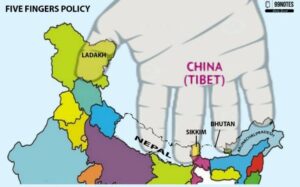
- China and India have been together at various fora like the IMF and the WTO and have expressed their solidarity against the position adopted by developed countries, which is unfavourable to the developing countries. India and China are emerging countries, and both are against the tilt of global trade rule in favour of developed countries. Thus, they have fought a common battle against developed countries in WTO. For example, China and India have opposed the huge subsidies that the U.S. and E.U. give to farmers at the WTO.
- Convergence on the issue of climate change: China and India are both members of the BASIC countries. They support each other in climate change negotiations; for example, BASIC was formed to increase mutual bargaining power with respect to Western countries.
- Membership in organizations– India and China supported the setting up of institutions like AIIB, NDB, etc., to challenge the dominance of the World Bank and IMF, respectively. NDB and the AIIB both came out of developing economies’ frustration with the Bretton Woods institutions.
- Western dominance of the World Bank shaped the institutions’ priorities and operations. In the post-Cold War era, Western countries, particularly the United States, emphasized the importance of reducing poverty and promoting democratic governance as key to achieving global stability. Thus, the World Bank neglected infrastructure funding in favour of poverty relief and ‘good governance’. Infrastructure needs of developing countries was neglected which are essential for long-term economic growth and development.
- In addition, the IMF imposed conditionality in its lending, seeking to use development financing as a tool to encourage policy change in the borrowing countries.
Cultural Exchange:
India and China has historical cultural relationship. This has provided a new dimension to the relationship of the two countries. Following are the various cultural connection has been established between two countries:
- Yoga: India has promoted yoga in China, with events like International Yoga Day being celebrated widely. The India-China Yoga College in Kunming, established in 2015, is a symbol of cultural collaboration.
- Art and Cinema: Indian films, particularly Bollywood, have found a growing audience in China. Films like “Dangal” and “3 Idiots” have been popular, promoting a cultural connection through cinema.
- Sister city relationship: Several city in India and China has established sister-city relationship to foster cultural, educational, and economic exchanges. For example Delhi-Beijing and Mumbai-Shanghai have developed a sister-city relationship. It helps to develop mutual understanding through various engagements including cultural festivals, business forums, and educational exchanges.
Developmental Cooperation:
- Education Exchange Programme (EEP): India and China signed the Education Exchange Programme (EEP) in 2006, that is an holistic agreement for educational cooperation between India and China. Under this agreement, government scholarships are awarded to the students by both sides in recognized institutions of higher learning in each other’s country. This has resulted in an increase in the number of Indian students at Chinese universities.
Area of divergence
Border issue:
There are border disputes between India and China due to the lack of boundary delimitation. The 3488 Km of the India-China border is not fully demarcated, and the process of clarifying and confirming the Line of Actual Control is in progress. The Indo-Tibetan Border Police Force (ITBP) is the Border Guarding Force at Indo-China Border.
| Line of Actual Control |
| Line of Actual Control (LAC) is divided into three main sectors: Western Sector, Middle Sector and Eastern Sector. Name of the Sector States/U.T. included Western sector Jammu Kashmir and Ladakh Middle Sector Himachal Pradesh and Uttarakhand Eastern Sector Sikkim and Arunachal Pradesh |
Claim on Sovereign land of India:
- China claims the territory of the neighbouring country through its five-finger policy that was given by Mao Zedong. According to this, Tibet is the Palm of the Right hand of China and the five fingers of Nepal, Sikkim, Arunachal Pradesh, Bhutan, and Ladakh. According to this, it is China’s responsibility to “liberate” these regions.
- Claim on Arunachal Pradesh: China claims 90,000 square kilometres of territory in India’s northeast. China claims the Arunachal Pradesh as a part of Tibet, which China occupied in 1951. China’s People’s Liberation Army (PLA) has been patrolling inside Arunachal Pradesh, causing a grave threat to India’s security.
- Aksai Chin: China captured Aksai Chin during the 1950s and increased its military grip over it during the 1962 war, claiming it as part of the ancient and medieval Chinese empire.
| Brief history of Aksai Chin |
|
Aksai Chin is a cold desert that does not receive rain or snow. It receives water from the Karakash River and brackish lakes. Aksai Chin is a part of Laddakh, which had trade and cultural relations with Tibet.
China Strengthened its position in the 1962 war and decided the LAC unilaterally in Laddakh. |
Border Clashes:
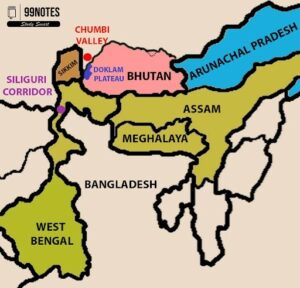
- Standoff at the Doklam Plateau: Doklam is an area spread over less than 100 sq km which comprises a plateau and a valley at the trijunction between India, Bhutan and China. Doklam is surrounded by the Chumbi Valley of Tibet, Bhutan’s Ha Valley and Sikkim. China has been increasing its military presence in the disputed Doklam Plateau. It has been extending the road southward in Doklam. India is against the Chinese presence in the Doklam Valley as it gives a strategic advantage to China. It would give them a commanding view of and easy access to both the Chumbi Valley and the Siliguri Corridor.
| Chicken’s Neck |
| It is a 60-kilometre-long and 22-kilometre-wide corridor in the Indian state of West Bengal, also known as the “Siliguri Corridor”. It connects India’s northeastern states with the rest of the country. The Siliguri Corridor is a strategically important and highly sensitive territory, as it remains the only bridge between the eight northeastern states of India and the rest of the country. It also links India to neighbouring Nepal, Bangladesh and Bhutan. |
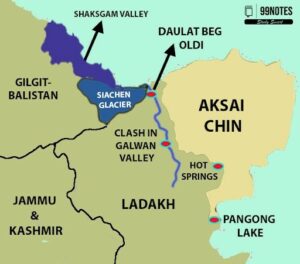
Galwan Valley Clash: Galwan Valley clash occurred on June 15, 2020, along the Line of Actual Control (LAC) in eastern Ladakh. The clash resulted in the deaths of 20 Indian soldiers and an undisclosed number of Chinese troops. India’s construction of a new road to a high-altitude air base is seen as one of the main triggers for a deadly 2020 clash with Chinese troops. Despite military-level talks, tensions continued.
| Infrastructure at LAC |
|
Daulat Beg Oldie (DBO) airstrip: DBO lies a mere 8 km south and 9 km west of the Line of Actual Control (LAC) and is an airfield of strategic importance.
|
- Issues at Pangong Lake in eastern Ladakh: Pangong Lake is a brackish water lake at the junction of Tibet and Laddakh.China has built subterranean bunkers to store fuel and weapons. People’s Liberation Army (PLA) has established a post at Sirjap, hidden among mountains on the northern bank of Pangong Lake. It was established in an area claimed by India and is around 5 km from the Line of Actual Control (LAC). This shows China’s military is preparing for the long haul in the area.
Issues at the Patroling points: China is notmaintaining the status quo ante at the LAC, with India losing possession of 26 patrolling points out of 65, including points in the Depsang Plains, Demchok and Gogra Hot Springs area.
Economic Issues:
- Trade deficit: The trade deficit between the two countries is very high, which is in favour of China. The trade deficit with China has exceeded $387 billion over six years.
- Non-Tariff barrier: China uses four significant barriers to regulate imports from countries like India that include regulatory, trade defense, internal market, and political barriers. China stifle competitive imports from India through complex regulations. Further it give more preference to the domestic firms as compare to the imported products.
- Dependency On Chinese Export: India imports 90 per cent of bulk drugs or APIs (active pharmaceutical ingredients) from China that are used in the pharmaceutical industry.. This import dependency causes major concern as it may risk the health security of the people in case of disruption in the supply Chain.
- Strategic concern of China’ Investment: After Galwan Clash India made security clearance mandatory for foreign direct investment (FDI) coming from countries that share a land border with India. It was probably to prevent the opportunistic takeover of Indian companies in the economically vulnerable period during COVID.
- Malpratice of Chinese firms: Chinese companies has been accused of violating the Companies Act 2013. To circumvent the FDI regulation, they are suspected of establishing shell companies in India. India’s Directorate of Revenue Intelligence has also accused Chinese smartphone companies like Xiomi and Oppo for custom duty evasion.
- Privacy Concerns: There has been allegation that Chinese companies had been gathering the personal data of a large number of Indians, reportedly for the benefit of senior members of the Chinese Communist Party.
Geostrategic Competition:
Indian Ocean Militarisation: Indian Ocean Region (IOR) has become arena for geostrategic competition. China is seeking to establish a greater military presence and a more robust operational foothold in the IOR.China is following String of Pearls strategy. It aims to encircle India by building military bases around it. E.g. China has built a Military base in Djibouti.
| String of Pearls |
|
String of Pearls is a strategy used by China to increase its access to the Indian Ocean with the help of the build-up of various infrastructures, such as ports. Though China claims it is for economic purposes and to strengthen its supply chain, India and the U.S. are of the view that there is a strategic angle to these developments. They believe that China can use this infrastructure to increase its regional supremacy.
|
- On QUAD: Quad is an informal strategic platform composed of US, Australia, India and Japan. China calls it Asian NATO and a containment strategy against China. China sees the grouping as a potential strategic alliance aimed at containing its influence in the Indo-Pacific region.
- India’s relation with the West: China treats U.S. as a geostrategic threat. Whenever India strengthens its relations with the West in the areas of economic, Defence and technological sphere, China sees it as a step against it.
- China- Pak Axis: The China-Pakistan axis is seen as a threat by India. It can the two-front war against India. Further, China helped Pakistan in developing nuclear capabilities, supplies military hardware, including advanced weapons and technology which enhanced Pakistan’s military capabilities which is a major concern for India.
- New markets: India is facing tough competition from China in markets of Africa, Asia, and Latin America. China’s aggressive investment strategies, infrastructure projects under the Belt and Road Initiative (BRI), and its ability to offer competitive pricing on goods and services have given it an edge in these regions.
| Belt and Road Initiative (BRI) |
So far, over 200 BRI cooperation agreements have been signed with more than 150 countries and 30 international organizations. While the BRI has the potential to boost global trade, it has faced criticism for creating debt dependency, lack of transparency, and geopolitical concerns. |
Issues in the India’s neighbourhood:
- India is against the Chinese project: CPEC (China-Pakistan Economic Corridor) is a part of BRI project. It aims to connect Gwadar Port in Pakistan’s Balochistan province with China’s Xinjiang region, providing China with a direct trade route to the Arabian Sea. However, India raised concern over it as it passes through disputed region of Gilgit-Baltistan, which is part of Pakistan-occupied Kashmir (POK). It will make China a stakeholder in the Kashmir issue, which India calls a bilateral issue between India and Pakistan.
- China’s aggressive diplomacy: China is using the debt trap and cashbook diplomacy in the neighbouring countries. It makes the China against India.
| Debt Trap and Cashbook Diplomacy |
|
Debt Trap diplomacy: This is a strategy in which a powerful country extends excessive credit to a less developed country with the objective of gaining a political or strategic advantage. It is often called as coercive diplomacy, where the debtor nation may lose sovereign control of the strategic assets. For example, Sri Lanka had to lease the Hambantota Port to China for 99 years after failing to repay Chinese loans Cashbook Diplomacy: It is the use of financial instruments such as grants, aid, or investment to gain diplomatic influence or political gain. It is less coercive than debt diplomacy. For example, China has used investments in African countries to gain their support in international forums. |
Other issues:
- Issue of the definition of terrorism – China put a technical hold on the proposal of India and the USA to designate Lashkar-e-Taiba (LeT) terrorist Shahid Mahmood as a global terrorist. Similarly, China has put a hold on a proposal moved at the United Nations by the U.S. and co-supported by India to designate Sajid Mir, who was involved in the 26/11 Mumbai terror attacks.
- Permanent membership of UNSC –China is against India’s candidature in UNSC. Since China is the only Asian power represented in the U.N. Security Council, it does not want any other Asian country to share this privilege. Further, China uses its veto power to support Pakistan.
- Dalai Lama’s issue –The Dalai Lama, the spiritual leader of Tibetan Buddhism, fled to India in 1959 following a failed uprising against Chinese rule in Tibet. India granted him asylum, and he established a Tibetan government-in-exile in Dharamshala, India. India’s support for the Dharamsala regime is seen by China as a threat to territorial sovereignty as it considers Dalai Lama as separatist leader.
- River Dispute: River issue between India and China is mainly centred on the Brahmaputra River. Brahmaputra River originate in the Tibet region. China is building dams on the Brahmaputra River that may affect the water security in the downstream. Further, China is not disbursing river data and it is claimed that China can use the river as a weapon against India at the time of war.
Steps taken to improve the relation
- Border Management: Various agreements and talk has been held to resolve the Border issues between two countries. For example Eight border guarding principles were agreed upon to resolve the differences between the two countries. Further, Border Defence Cooperation Agreement (BDCA) has been signed in 2013.
- Multilateral cooperation:
- BRICS was formed to strengthen the cooperation between emerging countries.
- India and China participate in joint counter-terrorism exercises under the SCO framework, contributing to regional stability.
- An informal summit between India and China was held in Wuhan and Mallapuram to reset the ties between the two countries.
- Confidence-Building Measures: Joint military exercises, such as the “Hand-in-Hand” series, have been conducted to enhance mutual understanding.
The Way Forward: Pragmatic China Policy
- There is a need for a multipronged approach with economic engagement and assertiveness in the international forum. Various measures that can be taken are as follows:
- Mutual agreement for solving border issues: We need to organize regular open dialogue to build trust and demilitarise armed forces deployed in the border areas. Further, there is a need to resolve the border issues based on eight broad principles agreed between the two countries.
- Strengthening the manufacturing base: Focusing on reform in the manufacturing sector will help reduce dependency on China. Further, it will help in increasing the competitiveness of Indian industries. Funding the start-ups and making a start-up-friendly ecosystem will help them gain competence in new areas.
- Neighbour’s first policy is to strengthen bilateral relations between India and neighbouring countries like Nepal, Bangladesh, Sri Lanka, Maldives, etc. so that China will not be able to utilize any dissatisfaction against India. Utilize the BIMSTEC for strengthening the regional cooperation in South Asia
Thus, a multifaceted approach will be needed to protect the strategic autonomy, sovereignty and integrity of the nation.
PYQs
2021
- “The USA is facing an existential threat in the form of a China that is much more challenging than the erstwhile Soviet Union.” Explain.
- The newly tri-nation partnership AUKUS is aimed at countering China’s ambitions in the Indo-Pacific region. Is it going to supersede the existing partnerships in the region? Discuss the strength and impact of AUKUS in the present scenario.
2017
‘China is using its economic relations and positive trade surplus as tools to develop potential military power status in Asia’; in light of this statement, discuss its impact on India as her neighbour.

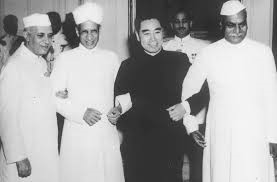
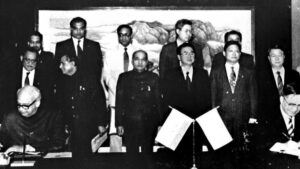
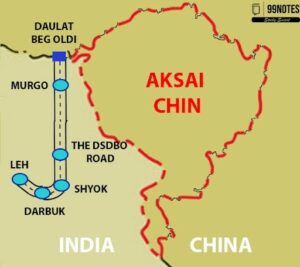 Daulat Beg Oldie: Daulet Beg Oldi is a small area lying at the base of the Karakoram Pass. Travellers on the Silk Route may have rested at DBO on their way to Constantinople from China and back. It has immense strategic implications, and the Indian Army has been at DBO since the late 1950s. DBO is adjacent to the Chip Chap River, with the air distance to the Karakoram pass at just 10 km. Darbuk-Shyok-Daulat Beg Oldie (DSDBO) Road: This is a 255-km long all-weather road built by India’s Border Roads Organisation in eastern Ladakh.
Daulat Beg Oldie: Daulet Beg Oldi is a small area lying at the base of the Karakoram Pass. Travellers on the Silk Route may have rested at DBO on their way to Constantinople from China and back. It has immense strategic implications, and the Indian Army has been at DBO since the late 1950s. DBO is adjacent to the Chip Chap River, with the air distance to the Karakoram pass at just 10 km. Darbuk-Shyok-Daulat Beg Oldie (DSDBO) Road: This is a 255-km long all-weather road built by India’s Border Roads Organisation in eastern Ladakh. The airstrip’s strategic importance lies in its proximity to the
The airstrip’s strategic importance lies in its proximity to the 